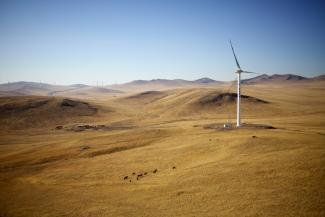Energy
Lower subsidies, more renewables
 Vergoz/Lineair
Vergoz/Lineair
Fossil-fuel subsidies amounted to just under $ 500 billion worldwide in 2014. For the first time ever, that was a small decline. Nevertheless, the remaining subsidies still harm the transition to renewable energies and energy efficiency, as Fatih Birol, IEA executive director, warned when he presented this year’s World Energy Outlook (WEO) ahead of the UN climate summit in Paris. In more general terms, Birol applauds the current dynamism of the development of renewable energies.
According to the WEO, renewables accounted for nearly half of the world’s new power-generation capacity last year. Over the coming five years, the IEA expects global renewable capacity to increase by more than 700 gigawatts. That is more than twice the output of all Japanese power stations. The trend is driven by the fast dropping costs of photovoltaic and wind power generation. The WEO forecasts that renewable energies will overtake coal as the largest source of electricity in the early 2030s and will become the leading source of new energy supply by 2040. Experts anticipate that 60 % of all investments will then flow into the renewables sector, especially in emerging and developing economies.
The IEA also sees positive trends in energy efficiency. According to the WEO, total global energy demand will increase by around a third by 2040, with net growth being driven entirely by developing and emerging economies. However, the IEA forecasts a less energy-intensive growth phase for the world’s biggest carbon emitter, China, in line with trends in Europe, Japan and the USA. Relevant issues include the rolling back of heavy industries, the shift towards services and related policy measures.
Today, half of Chinese energy consumption is subject to mandatory efficiency standards. Ten years ago, the share was a mere three percent. China wants to curb coal consumption by introducing an emissions trading system in 2017. It will apply to the power sector and heavy industry. A major increase in wind, solar and nuclear power generation is planned as well. Even so, the IEA expects that total Chinese energy demand will be nearly twice as high as that of the USA.
Brief stimulus
The IEA sees a problem in the currently low price of fossil fuels. For one thing, it reduces the incentive for improving energy efficiency and expanding the renewables sector; for another, it harms the global economy by exacerbating humankind’s dependence on a small number of oil exporting countries in the Middle East. “It is short-sighted to see low oil prices as a positive stimulus for the economy and a benefit for consumers,” Birol says. Low gas prices, he adds, jeopardise vital investment in infrastructure.
The IEA forecasts that market adjustments will push the oil price to $ 80 a barrel by 2020. At present, it stands at less than $ 50 a barrel. Birol appeals to IEA member countries to adopt policies to decarbonise energy supply. In his eyes, major challenges include achieving the transition to clean energy in India and Southeast Asia, where coal and gas growth rates are currently the sharpest.
“A significant course correction will be needed to meet the two degree target for global warming,” Birol says. If energy consumption and carbon cuts occur as forecast by the WEO, the two-degree target will be missed and mean global temperatures will rise by 2.7 degrees by 2100. Birol insists that “the world’s heads of state and government need to provide clear guidance in Paris to step up the pace of change in the global energy sector.” The framework for climate-change mitigation agreed at the summit, he says, needs to define a commitment that will enable the two-degree target to be met.
Hans-Christoph Neidlein